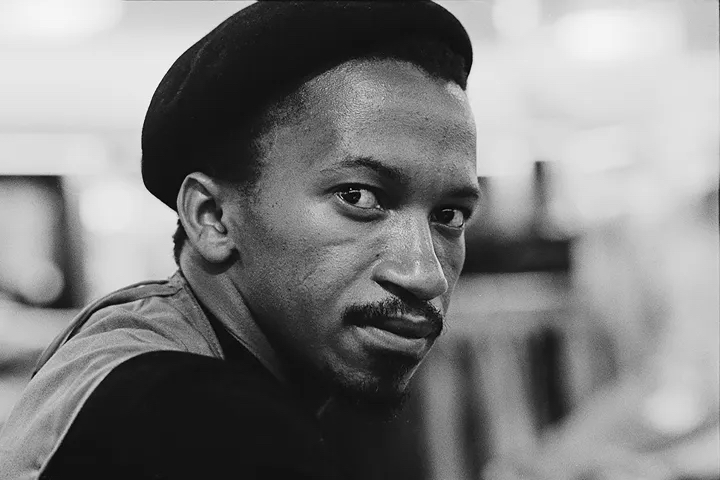In a new documentary, now showing in Dutch cinemas, Raoul Peck creates a space for the South African photographer to tell his own story.
Raoul Peck is one of the world’s most celebrated documentary filmmakers. Since the 1970s, he has created socially engaged films on subjects that are as critical as they are diverse—ranging from the death of Congo leader Patrice Lumumba (Lumumba, Death of a Prophet), to the Rwanda genocide (Sometimes in April), the friendship between Marx and Engels (The Young Karl Marx), the brutal treatment of Blacks during colonialism (Exterminate All the Brutes), and, most famously, the life and art of James Baldwin (I’m Not Your Negro). A former Minister of Culture in his native Haiti, Raoul Peck has spent much of his life in exile.
Peck's latest film, Ernest Cole: Lost and Found, which premiered at Cannes in 2024, tells the story of the renowned South African photographer who revealed the horrors of apartheid to the world through his powerful 1967 book House of Bondage.
I speak from experience when I say that a documentary about a photographer can be challenging, as it raises the question: Whose camera do we celebrate, the filmmaker’s or the protagonist’s? Peck masterfully navigates this dilemma by allowing his camera to "enter" Cole’s images. In one particular photograph, showing a young Black man being interrogated by the police, Peck’s camera scans the crowd around him. We hear Cole ask each person in the photo what they are thinking and how they personally relate to the tense police interaction on the street, each one a potential next victim. Every Black face reveals a sense of tense anticipation, except for the face of the white man, which calmly affirms that things are the way they should be for the white minority.
The internal monologue is provided by the voice of actor LaKeith Stanfield. It is an alloy of criticisms and poetry found in the prose of House of Bondage, reinforced by letters Cole wrote and observations pieced together from testimonies of those who knew him. Although these are not Cole’s precise words, they are immensely powerful. Peck infuses the commentary with his own personal understanding of the loneliness and disorientation of a life in exile.
The publication of House of Bondage established Cole’s reputation, propelling him to instant fame. At the same time, the political impact of House of Bondage rendered him persona non grata in South Africa, forcing Cole into exile in the United States.
Upon arriving in New York, Cole is sent on assignment to the Deep South. His white clients hope he can replicate House of Bondage in the recently desegregated and impoverished southern states of America. On their own, his American images are powerful and accomplished. However, comparisons with his South African work are inevitable. Cole’s South African images breathe injustice; they depict the harsh conditions Black South Africans endure with forensic precision. His American images, on the other hand, breathe a small gasp of hope. Many feature posters of Stokely Carmichael and Malcolm X on urban walls and shop windows, both indicators of a looming transition. This culminates in a beautiful sequence of photographs portraying mixed-race couples. These Black and white men and women, walking hand in hand, trigger a wave of joy and optimism in the otherwise emotionally burdened protagonist.
Cole’s American clients assumed that he could reproduce House of Bondage in the United States. This assumption exposes a simplistic understanding of photography and a disturbing view on race. Their reasoning, no doubt, stemmed from the belief that a Black photographer, whose reputation was built on documenting marginalised Black communities in South Africa, could recreate this work in the “right conditions”—namely, disenfranchised Black communities. As if the stark realities of Apartheid, which formed the basis of his photography, could be easily transposed to the United States. The verdict is harsh: “his American images aren’t edgy enough.” The Americans fail miserably in understanding that he lived his photography; they couldn’t fathom that Cole lived in the House of Bondage.
In reality, Cole is more out of place than a white photographer in the Deep South. His white colleagues could always rely on the authority that their skin colour provided. This is confirmed when we observe the white American faces in Cole’s images; they reveal a degree of suspicion, with faces marked by palpable rage, simmering just beneath the surface. Cole confesses that he feels unsafe in the Deep South, more so than in South Africa. “In South Africa, I might get arrested; here, I’m constantly afraid of being shot.” Cole refers to his South African photography as “collecting evidence” and apartheid as “the monster” that sometimes looks him in the eye. This is brilliantly visualised by a piece of propaganda showing the architect of apartheid, Hendrik Verwoerd, describing his policy of segregation as “good neighbourly.” The scene portrays the depraved absurdity of the apartheid regime with chilling precision.
Seamlessly, we move to a sequence of photographs that may seem familiar. South African photographers who worked under Apartheid have, at some point, taken a photograph of a Black nanny and a white toddler. The most iconic is a photograph by Peter Magubane, a contemporary of Ernest Cole.
These photographs of affection are highly effective as they expose small cracks in the otherwise ruthless system of Apartheid. The images immediately force the viewer to contemplate whether this open display of love will survive into adulthood. While pondering this, Peck shakes us awake with the nanny's voice: “I love this child, even though she will grow up and treat me just like her mother does. But now she is innocent.” The sequence is followed by a series of photographs of Black maids working in white homes, “these homes are crucibles of racism, here the races meet as master and servant.” This already powerful scene is sealed with the voice of a white female, highlighting the benefits of a booklet called Your Bantu Servant and You. The manual advises the reader “to speak to the servant in a language they understand and try to remember that they are human.” The white woman’s voice reminds us of featureless telemarketing voices, literally selling us Apartheid. Her engineered cheerfulness makes the message all the more harrowing.
It’s difficult to look at Ernest Cole’s haunting photography, which captures the struggle of South Africans during apartheid, and not immediately think about the current situation in Palestine. This is especially clear when Peck explains the impact of the Native Administration Act of 1927, a law that empowered the South African government to move any individual African or entire tribe—when in the public interest—from any place in South Africa to any other place, without prior notice or any time limit. With this in mind, Peck retraces Cole’s 1964 trip to the banishment camp Frenchdale, an isolated outpost near the border of Botswana. His photographs of Frenchdale and its exiles are poignant, lacking all references to the cadence of daily life. It is here that the West Bank and Gaza resonate the loudest.
On returning to Johannesburg from Frenchdale, Cole states, "As I re-entered the restricted Black life of Johannesburg, I felt free."
Lost and Found salvages Ernest Cole’s voice. The film refrains from talking heads and external perspectives, instead creating a space for this remarkable artist to tell his own, long-overdue story.
Watch the trailer here.
Call to Action
ZAM believes that knowledge should be shared globally. Only by bringing multiple perspectives on a story is it possible to make accurate and informed decisions.
And that’s why we don’t have a paywall in place on our site. But we can’t do this without your valuable financial support. Donate to ZAM today and keep our platform free for all. Donate here.


